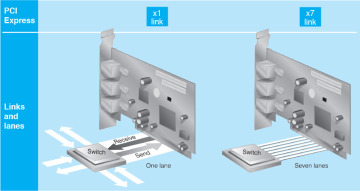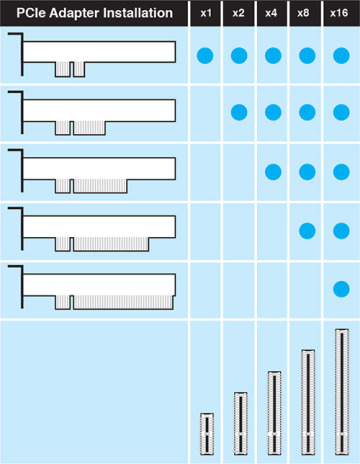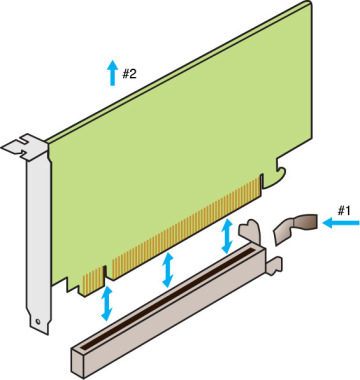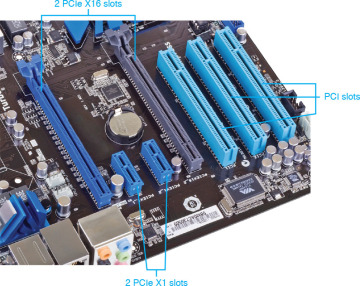- On the Motherboard Overview
- Processor Overview
- Processor Basics
- Speeding Up Processor Operations Overview
- Cache
- Clocking
- Threading Technology
- Connecting to the Processor
- Multi-Core Processors
- Graphics Processing Unit (GPU)
- Virtualization
- Intel Processors
- CPU Sockets
- AMD Processors
- Processor Cooling
- Installing a Processor
- Upgrading Processors
- Overclocking Processors
- Installing CPU Thermal Solutions
- Troubleshooting Processor Issues
- Expansion Slots
- PCI (Peripheral Component Interconnect)
- AGP (Accelerated Graphics Port)
- PCIe (Peripheral Component Interconnect Express)
- Chipsets
- Types of Motherboards
- Upgrading and Replacing Motherboards
- Motherboard Troubleshooting
- Soft Skills-Active Listening
- Chapter Summary
- Key Terms
- Review Questions
- Exercises
- Activities
- Labs
PCIe (Peripheral Component Interconnect Express)
PCI, PCI-X, and AGP have been replaced with PCIe (PCI Express), which is also seen as PCI-E. PCIe outperforms all other types of PCI expansion slots. Table 3.7 shows different PCIe versions.
TABLE 3.7 PCIe versions
PCIe version |
Speed (per lane per direction) |
1.0 |
2.5GT/s (gigatransfers per second) or 250MB/s |
2.0 |
5GT/s or 500MB/s |
3.0 |
8GT/s or 1GB/s |
4.0 |
16GT/s or 2GB/s |
The older PCI standard is half-duplex bidirectional, which means that data is sent to and from the PCI or PCI-X card using only one direction at a time. PCIe sends data full-duplex bidirectionally; in other words, it can send and receive at the same time. Figure 3.31 shows this concept.

Figure 3.31 A comparison of PCI/PCI-X and PCIe transfers
The older PCI standards, including PCI-X, use a parallel bus where data is sent with multiple 1s and 0s simultaneously. PCIe is a serial bus, and data is sent one bit at a time. Table 3.8 shows a comparison of the PCI, PCI-X, AGP, and PCIe buses.
TABLE 3.8 Comparing bus bandwidth
Bus |
Maximum bandwidth |
PCI |
133 or 266MB/s (depending on bus speed) |
PCI-X |
266–4,266MB/s (depending on bus speed) |
AGP 2x |
533MB/s |
PCIe x1 |
250MB/s (in each direction) |
PCIe x2 |
500MB/s (in each direction) |
PCIe x4 |
1,000MB/s (in each direction) |
PCIe x8 |
2,000MB/s (in each direction) |
PCIe x16 |
4,000MB/s (in each direction) |
PCIe x32 |
8,000MB/s (in each direction) |
Another difference between PCI and PCIe is that PCIe slots come in different versions, depending on the maximum number of lanes that can be assigned to the card inserted into the slot. For example, an x1 slot can have only one transfer lane used by the x1 card inserted into the slot; x2, x4, x8, and x16 slots are also available. The standard supports an x32 slot, but these are rare because of the length. An x16 slot accepts up to 16 lanes, but fewer lanes can be assigned. Figure 3.32 shows the concepts of PCIe lanes. Notice how one lane has two unidirectional communication channels. Also note how only seven lanes are used. PCIe has the capability to use a reduced number of lanes if one lane has a failure or a performance issue.

Figure 3.32 PCIe lanes
A PCIe x1 adapter can fit in an x1 or higher slot. A larger card, such as a PCIe x16, cannot fit in a lower-numbered (x8, x4, x2, or x1) slot. Figure 3.33 shows this concept.

Figure 3.33 Correct slots for PCIe cards
Removing an adapter is normally just a matter of removing a retaining screw or plate and lifting the adapter out of the slot. Some AGP and PCIe expansion slots have retention levers. You move the retention lever to the side in order to lift the adapter from the expansion slot. Figure 3.34 shows an example of the PCIe adapter removal process. Figure 3.35 shows a motherboard with two x1 PCIe, two x16 PCIe, and three PCI expansion slots. Notice that the PCIe x16 slot has a retention lever.

Figure 3.34 PCIe adapter removal

Figure 3.35 Motherboard with PCIe and PCI slots
PCI, PCI-X, AGP, and PCIe are important for connectivity in both workstation and portable computers. Traditional PCI connectivity will need to be supported for several more years in new machines for backward compatibility and in computers already in use. PCIe is the current bus for internal and external device connectivity.